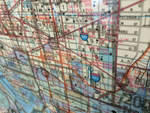If you're planning to rent a car on a road trip in another country and you think you can simply use your mobile phone for step-by-step driving directions, think again.
Technology can be wonderful, but modern corporations aren't. They work against current advances in roaming privileges by restricting your use of them when you travel.
Waze and the mapping systems of major navigation apps work brilliantly—at home. And they work brilliantly abroad, too—if you live there. But once you take your phone away from your home county and use a foreign data network, the speed of your data access is likely to be too slow for your navigation app to keep up.
Even if you have international roaming turned on, your mobile phone carrier probably throttles the speed at which you're allowed to download data when you're in other countries. Many traveling mobile phone customers get data at much slower rates than locals do. T-Mobile, for example, promises "high-speed" data, but the fine print reveals that in some places, that could be as slow as 256 Kbps, which is galacial by modern standards.
You may think your phone carrier offers robust international plans that grant unlimited data and unlimited texts. But you'll usually find that those "unlimited" promises are still hogtied by molasses-slow data speeds. Your carrier probably doesn't trumpet the fact that its international speeds are drastically curtailed, so be sure to ask what they will be. If they're as fast as they are back home, then problem solved.
In most cases, though, your phone's international data speed won't be able to keep up with driving directions, especially in cities when you'll need to make a lot of turns quickly. Your screen could be frozen in a constant state of loading—and you'll miss turns and get lost.
The problem is compounded by the fact that precious few rental car companies give out printed maps anymore, and the maps that do exist are not very detailed.
Here are some fixes:
1. Buy a supplemental plan that allows for proper high-speed data. These are costly, though, and they come with ceilings on the amount you're allowed to download (US$35 for 5 GB is common, and that goes fast). It's easy to breeze through your data allowance in hours, suddenly leaving you directionless and forced to pull over to pony up more cash for more data at a workable speed.
2. Download the required map data from home ahead of time. Both the Google Maps and Apple Maps smartphone apps on iPhone and Android allow you to download map info for another location so you wont require a connection to access it later. Find the locations you need in the app and look for the "download" or "download offline map" button, but make sure you download data all along your planned route. The downsides are that the maps will take up some space on your phone (but can be deleted after your trip) and the maps won't include current traffic information. But they'll work well enough to give you step-by-step driving directions.
3. Make sure your smartphone is "unlocked" and buy a local SIM card that permits normal data speeds. This option is not for beginners, obviously, and outlets that sell SIM cards are dwindling as more standard mobile phone plans allow for international roaming.
4. Bring your own hand-held GPS directional unit (not a phone) and plug it into the car for power. There may be data issues here, too—each system has its own way of working. And it's one more bulky item to pack.
5. Reserve a hand-held GPS unit from the rental car location. Less expensive, but increasingly rare now that most people are using their phones for driving directions. Rental companies are often out of units, too, forcing you to accept a higher rental rate for a car with a built-in system.
6. Bring a good map. I know—crazy, right?






